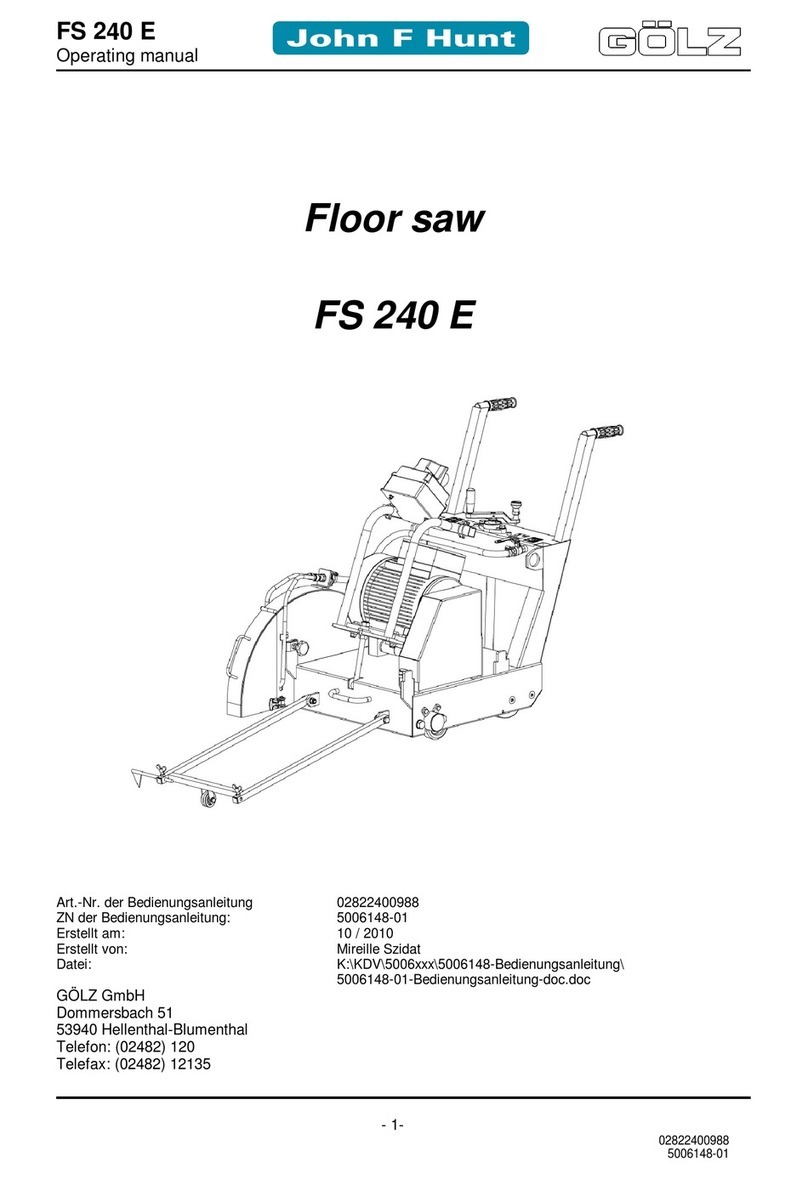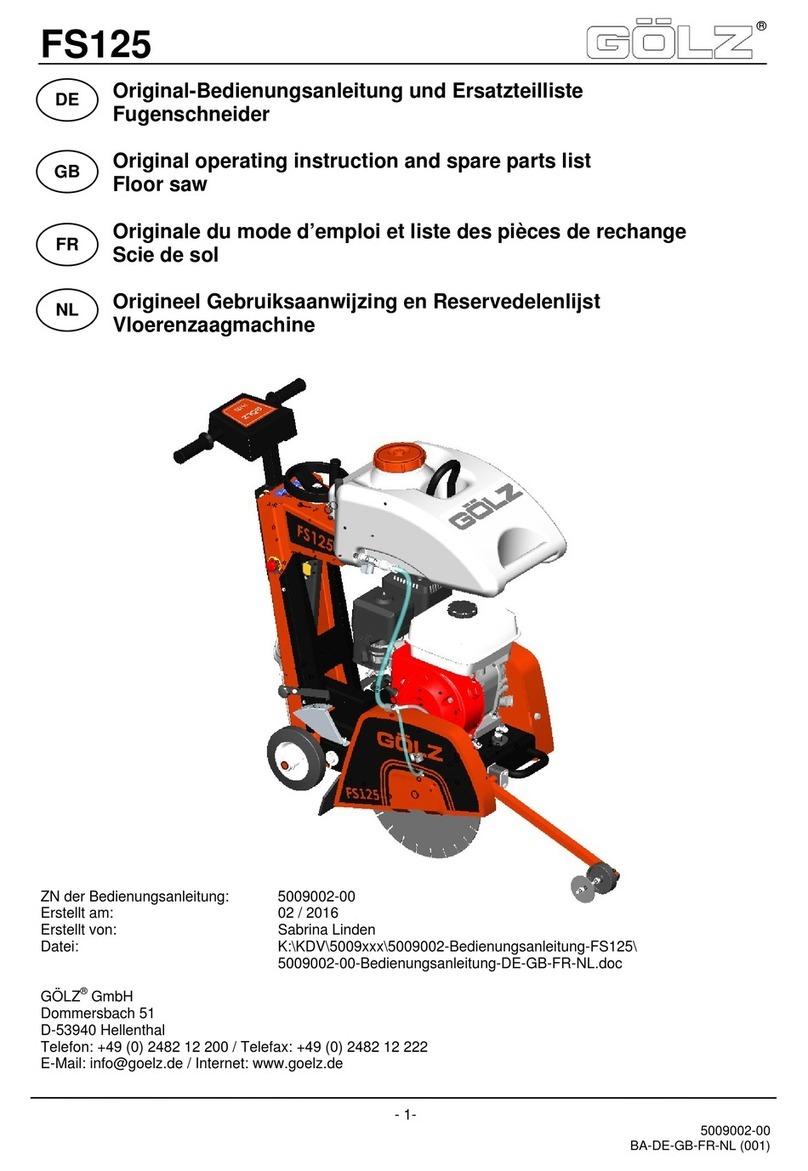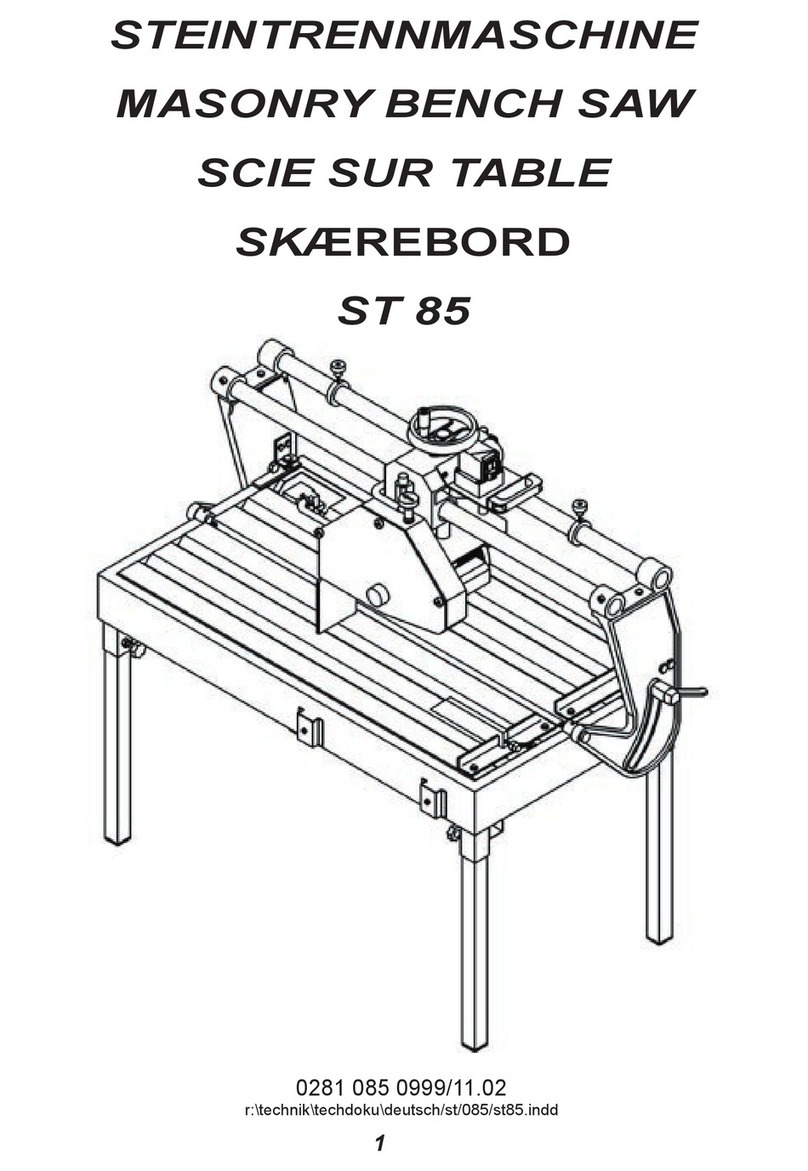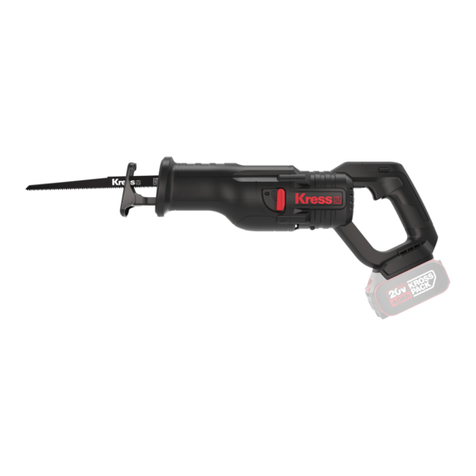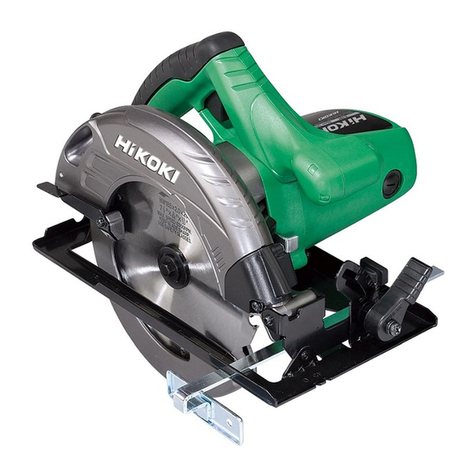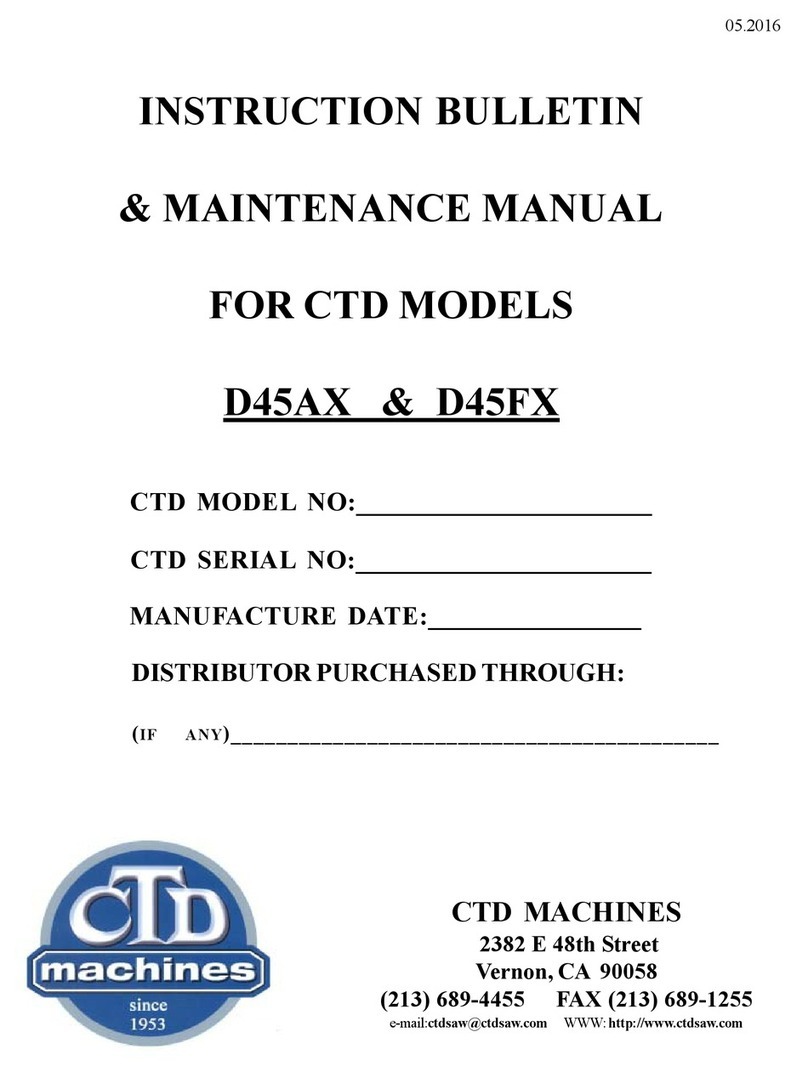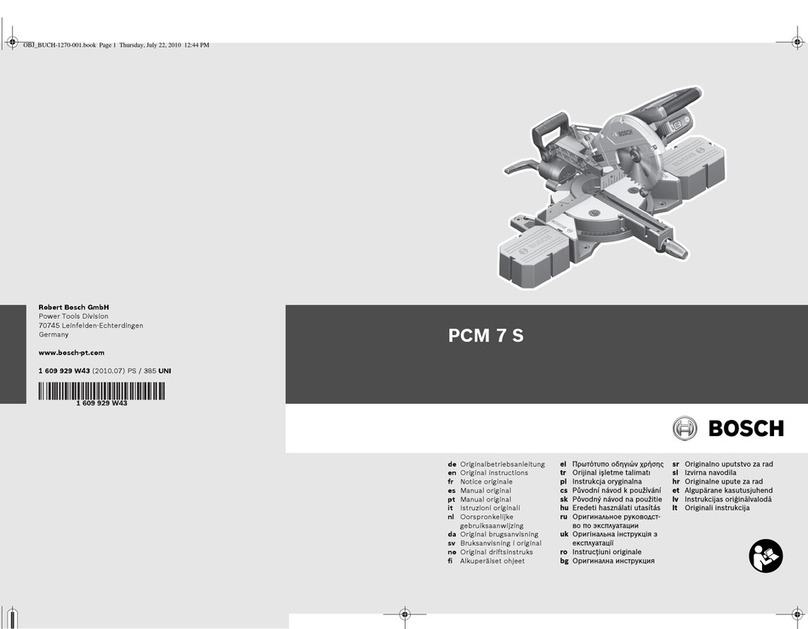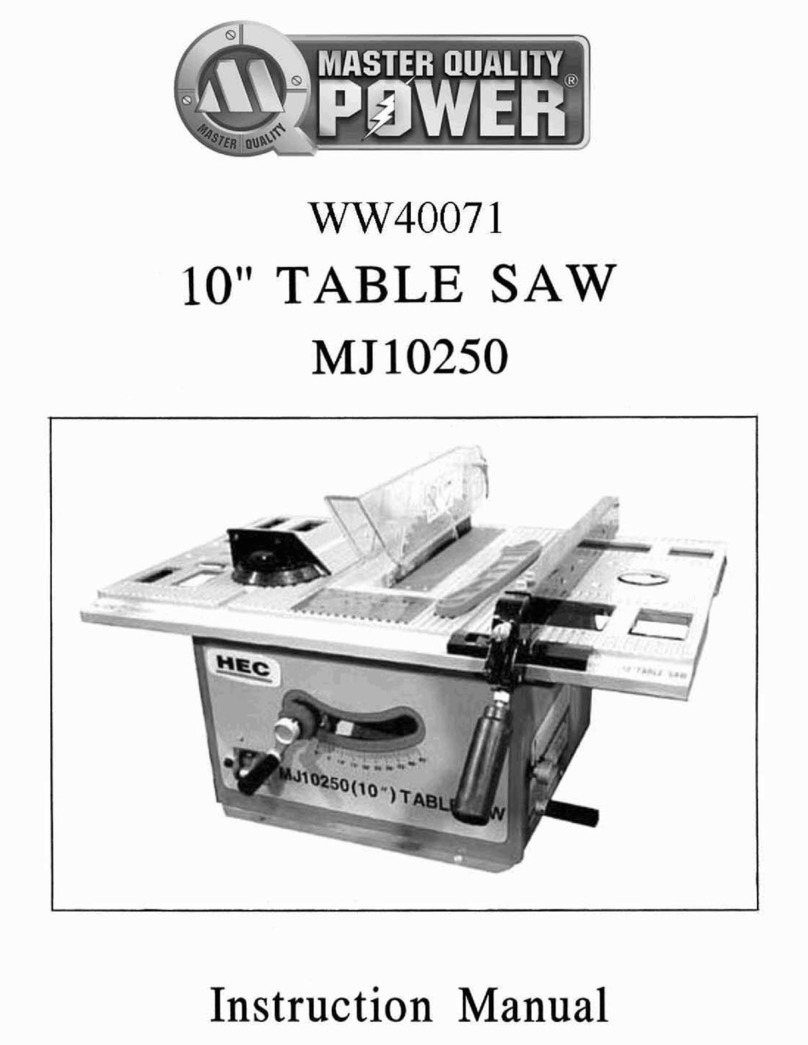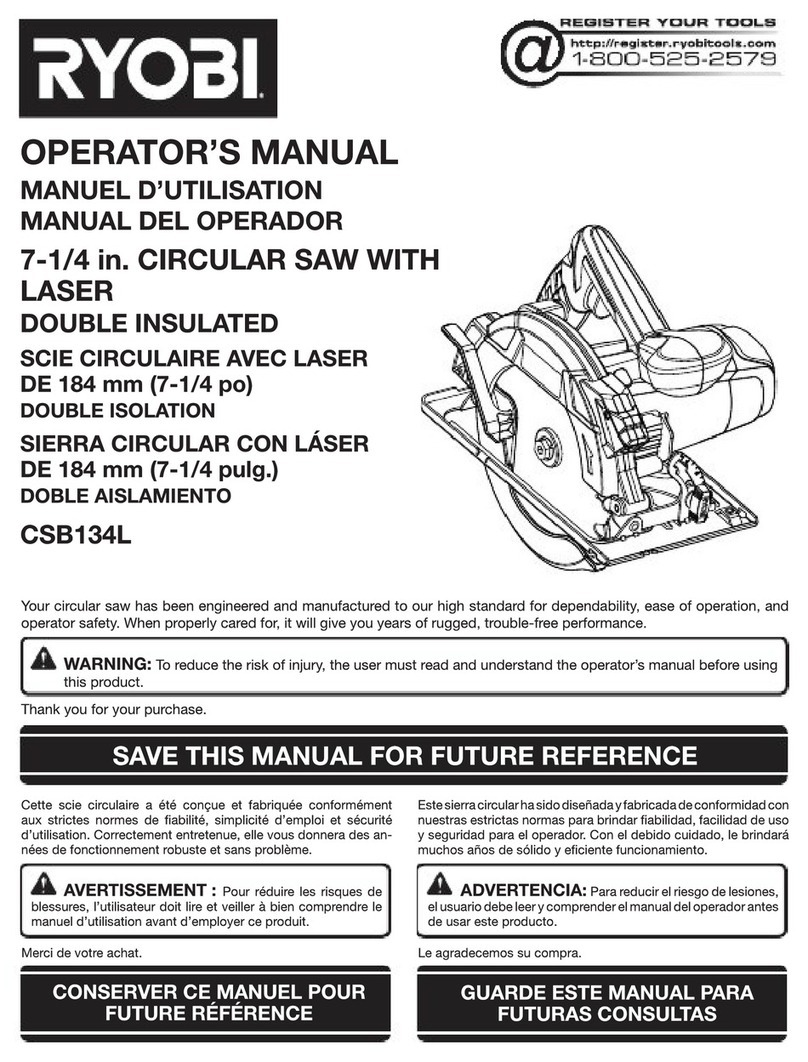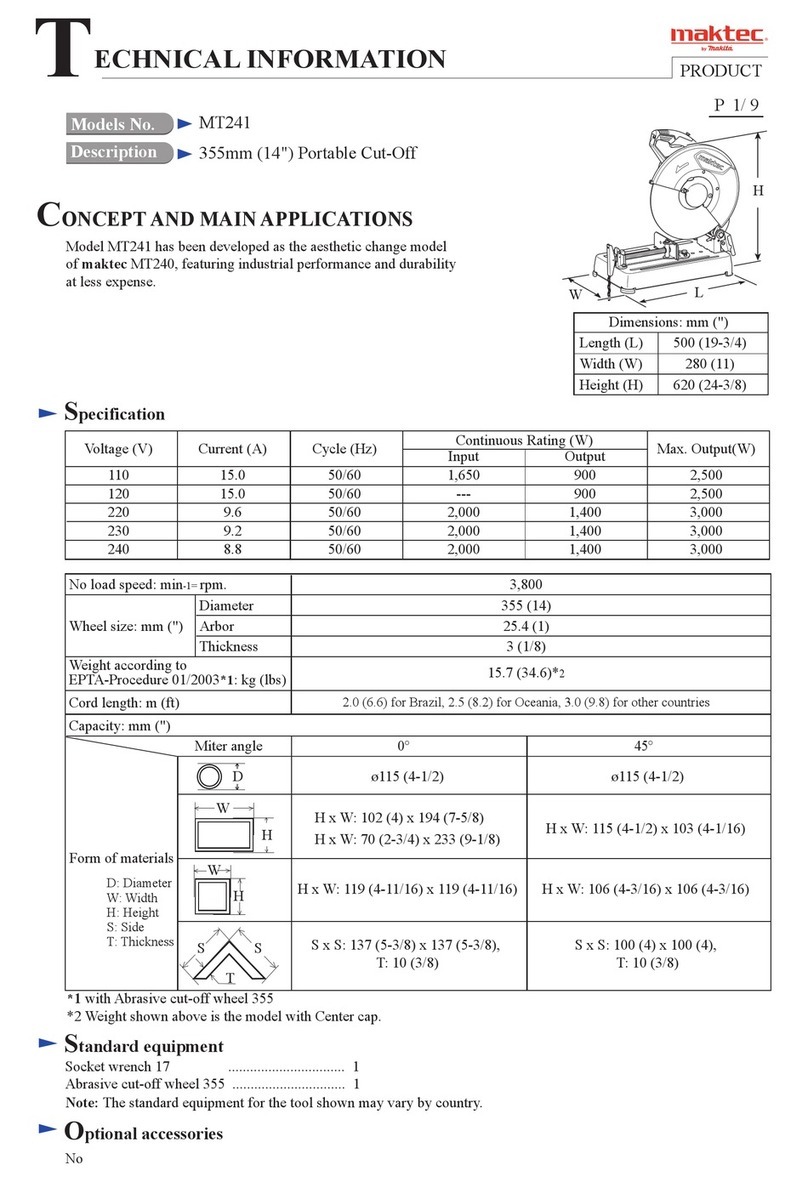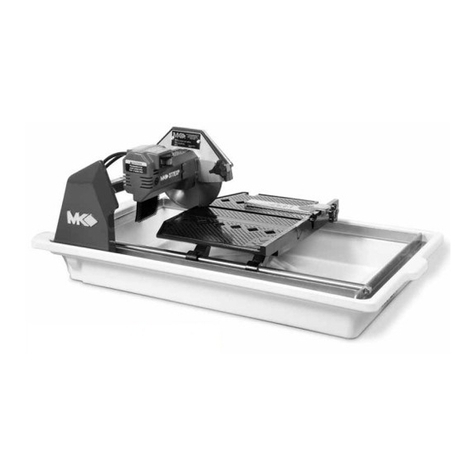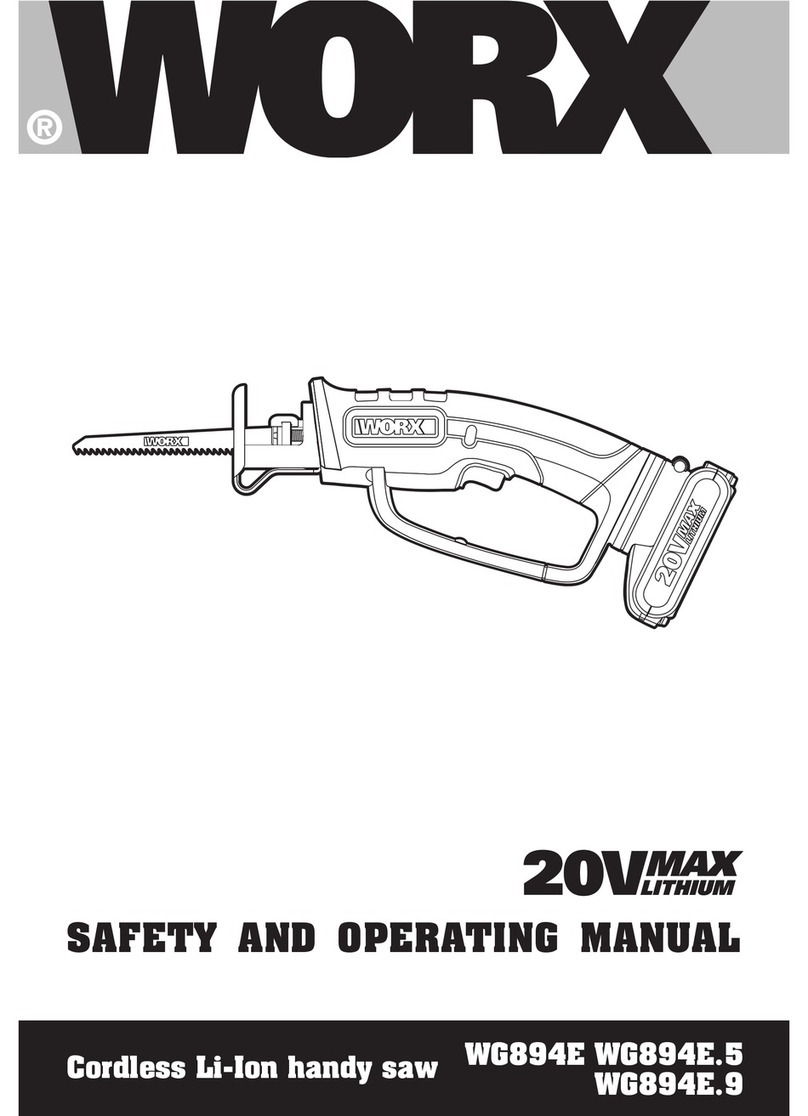GÖLZ FS 250 B User manual

1
FLOOR SAW
FS 250 B
0282 250 0958/12.05
r:\technik\techdoku\englisch\fs\250b\2000958\02822500958_02_14-12-05.indd

2
FS 250 B
3
GÖLZ
GmbH
Dommersbach 51
D-53940 Hellenthal-Blumenthal
Phone: (02482) 120
Telefax: (02482) 12135
December,16th 2003
We declare, the product
Name:
FLOOR SAW
Manufacturer:
GÖLZ
Type:
FS 250 B
Serial number: __________
is in conformity with the Directives
- 98/37/EC
- 89/336/EWG i.d.F. 93/68/EWG
- 2000/14/EC
as well as with the standards
- EN 13682:2001
- EN 13309:2000; EN 61000
- EN ISO 3744:1995
..................................
Chief designer
CE-Declaration of Conformity

2
FS 250 B
3
All rights reserved!
We endeavour continuously to improve the quality of our products and adapt them to the
highest technical standards. The text and gures in this operating instruction can therefore
differ from your equipment.
© Copyright
GÖLZ
Contents
1. Basic informations ............................................... 4
2. Fundamental safety instructions ........................ 4
3. Description............................................................ 9
4. Transport............................................................. 11
5. Installation and operation.................................. 12
6. Maintenance........................................................ 16
7. Troubleshooting ................................................. 19
8. Spare parts list ................................................... 21
9. Connection diagram........................................... 40

4
FS 250 B
5
The following signs and designations are used in the manual to designate instructions of particular impor-
tance:
Information: Refers to special information on how to use the machine most efciently
Attention: Refers to special information and/or orders and prohibitions directed
towards preventing damage
Danger: Refers to orders and prohibitions designed to prevent injury or extensive
damage
The following signs are used on the machine and in the manual:
2. Fundamental safety instructions
2.1 Warnings and symbols
Important
information!
General danger warning!
Do not touch! Wear safety glasses!
Read owner’s manual
before the rst initia-
tion!
Wear safety
helmet!
Wear ear
protection!
Wear safety
boots!
Wear safety
gloves!
Wear safety
clothing!
1. Basic informations
Thanks for choosing a
GÖLZ
-product. This operating instruction is designed to familiarize the user with the
machine and its designated use.
The operating instruction contains important information on how to operate the machine safely, properly and
most efciently. Observing these instructions helps to avoid danger, to reduce repair costs and downtimes and
to increase the reliability and life of the machine.
The operating instruction is to be supplemented by the respective national rules and regulations for accident
prevention and environmental protection. The operating instruction must always be available wherever the
machine is in use.
This operating instruction must be read and applied by any person in charge of work with or on the machine,
such as:
- Operation including setting up, troubleshooting in the course of work, evacuation care and disposal
of fuels and consumables.
- Maintenance (servicing, inspection, repair) and/or
- Transport
In addition to the operating instructions and to the mandatory rules and regulations for accident prevention and
environment protection of the country and place of use of the machine, the generally recognized technical rules
for safe and proper working conditions and procedures must also be observed.
During cuts displace the oor saw only with non
rotating blade (not running engine)!

4
FS 250 B
5
2.3 Organizational measures
n The operating instructions must always be at hand at the place of use of the machine, e.g. by stowing
them in the tool compartment or tool-box provided for such purpose.
n In addition to the operating instructions, observe and instruct the user in all other generally applicable
legal and other mandatory regulations relevant to accident prevention and environmental protection.
These compulsory regulations may also deal with the handling of hazardous substances, issuing and/or
wearing of personal protective equipment, or trafc regulations.
n The operating instructions must be supplemented by instructions covering the duties involved in super-
vising and notifying special organizational features, such as job organization, working sequences or the
personnel entrusted with the work.
n Personnel entrusted with work on the machine must have read the operating instructions and in particular
the chapter on safety before beginning work. Reading the instructions after work has begun is too late.
This applies especially to persons working only occasionally on the machine, e.g. during setting up or
maintenance.
n Check - at least from time to time - whether the personnel is carrying out the work in compliance with the
operating instructions and paying attention to risks and safety factors.
n The machine has been built in accordance with state-of-the-art standards and the recognized safety
rules. Nevertheless, its use may constitute a risk to life and limb of the user or of third parties, or cause
damage to the machine and to other material property.
n The machine must only be used in technically perfect condition in accordance with its designated use
and the instructions set out in the operating manual, and only by safety-conscious persons who are fully
aware of the risks involved in operating the machine. Any functional disorders, especially those affecting
the safety of the machine, should therefore be rectied immediately.
n Separation building implements are exclusively designed for sawing, slotting, drilling a.s.o. of abrasive
building material at building sites using tools in accordance with the manufacturer’s instruction.
n They are exclusively designed for cutting rm built-in building material.
n Using the machine for purposes other than those mentioned above (such as for) is considered contrary
to its designated use. The manufacturer cannot be held liable for any damage resulting from such use.
The risk of such misuse lies entirely with the user. Operating the machine within the limits of its desig-
nated use also involves observing the instructions set out in the operating manual and complying with
the inspection and maintenance directives.
2.2 Basic operation and designated use of the machine
n For reasons of security, long hair must be tied back or otherwise secured, garments must be close-tting
and no jewellery - such as rings - may be worn. Injury may result from being caught up in the machinery
or from rings catching on moving parts.
n Use protective equipment wherever required by the circumstances or by law.
n Observe all safety instructions and warnings attached to the machine.
n See to it that safety instructions and warnings attached to the machine are always complete and perfectly
legible.
n In the event of safety-relevant modications or changes in the behaviour of the machine during operation,
stop the machine immediately and report the malfunction to the competent authority/person.
n Never make any modications, additions or conversions which might affect safety without the supplier’s
approval. This also applies to the installation and adjustment of safety devices and valves as well as to
welding work on load-bearing elements.
n Spare parts must comply with the technical requirements specied by the manufacturer. Spare parts from
original equipment manufacturers can be relied to do so.

6
FS 250 B
7
2.4 Selection and qualication of personnel
n Any work on and with the machine must be executed by reliable personnel only. Statutory minimum age
limits must be observed.
n Employ only trained or instructed staff and set out clearly the individual responsibilities of the personnel
for operation, set-up, maintenance and repair.
n Make sure that only authorized personnel works on or with the machine.
n Dene the machine operator’s responsibilities - also with regard to observing trafc regulations - giving
the operator the authority to refuse instructions by third parties that are contrary to safety.
n Replace hydraulic hoses within stipulated and appropriate intervals even if no safety-relevant defects
have been detected.
n Adhere to prescribed intervals or those specied in the operating instructions for routine checks and
inspections!
n For the execution of maintenance work, tools and workshop equipment adapted to the task on hand are
absolutely indispensable.
n The personnel must be familiar with the location and operation of re extinguishers.
n Observe all re-warning and re-ghting procedures.
2.5 Safety instructions governing specic operational phases
Standard operation
n Avoid any operational mode that might be prejudicial to safety.
n Take the necessary precautions to ensure that the machine is used only when in a safe and reliable
state. Operate the machine only if all protective and safety-oriented devices, such as removable safety
devices, emergency shut-off equipment, sound-proong elements and exhausters, are in place and
fully functional. Before beginning work, familiarize yourself with the surroundings and circumstances of
the site, such as obstacles in the working and travelling area, the soil bearing capacity and any barriers
separating the construction site from public roads.
n Check the machine at least once per working shift for obvious damage and defects. Report any changes
(incl. changes in the machine’s working behaviour) to the competent organization/person immediately.
If necessary, stop the machine immediately and lock it.
n In the event of malfunctions, stop the machine immediately and lock it. Have any defects rectied im-
mediately.
n During start-up and shut-down procedures always watch the indicators in accordance with the operating
instructions.
n Before starting up or setting the machine in motion, make sure that nobody is at risk.
Special work in conjunction with utilization of the machine and maintenance and re-
pairs during operation; disposal of parts and consumables
n Observe the adjusting, maintenance and inspection activities and intervals set out in the operating in-
structions, including information on the replacement of parts and equipment. These activities may be
executed by skilled personnel only.
n Do not allow persons to be trained or instructed or persons taking part in a general training course to
work on or with the machine without being permanently supervised by an experienced person.
n Work on the electrical system and equipment of the machine must be carried out only by a skilled electri-
cian or by instructed persons under the supervision and guidance of a skilled electrician and in accord-
ance with electrical engineering rules and regulations.
n Work on the hydraulic system must be carried out only by personnel with special knowledge and experi-
ence of hydraulic equipment.

6
FS 250 B
7
n Brief operating personnel before beginning special operations and maintenance work, and appoint a
person to supervise the activities.
n In any work concerning the operation, conversion or adjustment of the machine and its safety-oriented
devices or any work related to maintenance, inspection and repair, always observe the start-up and shut-
down procedures set out in the operating instructions and the information on maintenance work.
n Ensure that the maintenance area is adequately secured.
n If the machine is completely shut down for maintenance and repair work, it must be secured against
inadvertent starting by:
- locking the principal control elements and removing the ignition key and/or
- attaching a warning sign to the main switch.
n To avoid the risk of accidents, individual parts and large assemblies being moved for replacement pur-
poses should be carefully attached to lifting tackle and secured. Use only suitable and technically perfect
lifting gear and suspension systems with adequate lifting capacity. Never work or stand under suspended
loads.
n The fastening of loads and the instructing of crane operators should be entrusted to experienced persons
only. The marshaller giving the instructions must be within sight or sound of the operator.
n Clean the machine, especially connections and threaded unions, of any traces of oil, fuel or preservatives
before carrying out maintenance/repair. Never use aggressive detergents. Use lint-free cleaning rags.
n Before cleaning the machine with water, steam jet (high-pressure cleaning) or detergents, cover or tape
up all openings which - for safety and functional reasons - must be protected against water, steam or
detergent penetration. Special care must be taken with electric motors and switchgear cabinets.
n After cleaning, remove all covers and tapes applied for that purpose.
n After cleaning, examine all fuel, lubricant, and hydraulic uid lines for leaks, loose connections, chafe
marks and damage. Any defects found must be rectied without delay.
n Always tighten any screwed connections that have been loosened during maintenance and repair.
n Any safety devices removed for set-up, maintenance or repair purposes must be retted and checked
immediately upon completion of the maintenance and repair work.
n Ensure that all consumables and replaced parts are disposed of safely and with minimum environmental
impact.
Electric energy
n Use only original fuses with the specied current rating. Switch off the machine immediately if trouble
occurs in the electrical system.
n Work on the electrical system or equipment may only be carried out by a skilled electrician himself or by
specially instructed personnel under the control and supervision of such electrician and in accordance
with the applicable electrical engineering rules.
n The electrical equipment of machines is to be inspected and checked at regular intervals. Defects such
as loose connections or scorched cables must be rectied immediately.
n Necessary work on live parts and elements must be carried out only in the presence of a second person
who can cut off the power supply in case of danger by actuating the emergency shut-off or main power
switch. Secure the working area with a red-and-white safety chain and a warning sign. Use insulated
tools only.
2.6 Warning of special dangers

8
FS 250 B
9
Noise
n During operation, all sound bafes must be closed.
n Always wear the prescribed ear protectors.
Oil, grease and other chemical substances
n When handling oil, grease and other chemical substances, observe the product-related safety regula-
tions.
n Be careful when handling hot consumables (risk of burning or scalding).
n For loading only use lifting gear and tackle of sufcient capacity.
n Appoint a competent marshaller to assist in the lifting operations.
n Lift machinery and equipment properly with suitable lifting gear and only in accordance with the operating
instructions (xing points for lifting tackle, etc . . .).
n Only use suitable means of transport of adequate carrying capacity.
n Fasten the loads safely using the suitable xing points.
n Before or immediately after completion of the loading operations the machine must be secured by means
of recommended/supplied devices against unintentional changes of position and a corresponding warn-
ing sign attached to the machine. Before recommissioning the machine these devices must be properly
removed.
n Carefully ret and fasten all parts to be removed for transport purposes before recommissioning the
machine.
n For recommissioning only proceed in accordance with the operating instructions.
2.7 Machinery and equipment used at frequently changing places of
operation)
Gas, dust, steam, smoke
n Carry out welding, ame-cutting and grinding work on the machine only if this has been expressly author-
ized, as there may be a risk of explosion and re.
n Before carrying out welding, ame-cutting and grinding operations, clean the machine and its surroundings
from dust and other inammable substances and make sure that the premises are adequately ventilated
(risk of explosion).
n Operate internal combustion engines and fueloperated heating systems only on adequately ventilated
premises. Before starting the machine on enclosed premises, make sure that there is sufcient ventila-
tion. Observe the regulations in force at the respective site.
Hydraulic and pneumatic equipment
n Work on hydraulic equipment may be carried out only by persons having special knowledge and experi-
ence in hydraulic systems.
n Check all lines, hoses and screwed connections regularly for leaks and obvious damage. Repair damage
immediately. Splashed oil may cause injury and re.
n Depressurize all system sections and pressure pipes (hydraulic system, compressed-air system) to be
removed in accordance with the specic instructions for the unit concerned before carrying out any repair
work.
n Hydraulic and compressed-air lines must be laid and tted properly. Ensure that no connections are in-
terchanged. The ttings, lengths and quality of the hoses must comply with the technical requirements.

8
FS 250 B
9
9. Adjustable handle bars
10. Feed-control lever
11. Dashboard
12. Electrical water pump
13. Lifting eye
14. Depth control
15. Fixing points
1. Frame
2. Undercarriage
3. Blade guard
4. Pointer unit
5. Flange guard
6. V-belt guard
7. Engine
8. Fuel tank
3. Description
3.1 Intended use-description
n Operate the oor saw only using tools in accordance with the manufacturer’s instruction. Using other
tools is considered contrary to its designated use. The manufacturer cannot be held liable for any dam-
age resulting from such use. The risk of such misuse lies entirely with the user.
n Operate petrol driven oor saws only with motor fuel the engine manufacturer species.
Information: Unconditional observe the owner’s manual of the engine manu-
facturer, which is added!
910 11
12
13
14
1
2
3
4
5
6
7
8
15
15
3.3 Safety devices
Danger: During cutting or displacing the oor saw, all safety devices shown
below must be mounted!

10
FS 250 B
11
Blade guard for max. blade size
of 800 mm - 31.5 in.
Maintenance ap
(rear side)
Mufer
guard
V-belt guard
Flange
guard
3.4 Technical data
Max. cutting depth: 280 mm - 8.65 in.
Max. blade-Ø: 800 mm - 31.5 in.
Blade shaft size: Ø 25.4 mm - 1 in.
Flange size: Ø 145 mm - 5.7 in.
Engine: KOHLER-petrol engine, 2-cylinder, 3600 rpm,
4-cycle, 18.5 kW (25 HP), air-cooled with
electric start
Blade shaft speed: 1600 rpm
Max. cutting speed with
blade size Ø 800 mm - 31.5 in.: 62,8 m/s - 175 ft./sec.
Feed: Electro-hydraulically traversing gear
Lifting: Electro-hydraulically quick-lifting
Water supply: Electrical water pump
V-belt tension: Automatically V-belt tensioner
Dimensions (L x W x H): approx. 1340 x 800 x 1040 mm
52.75 x 31.5 x 40.95 in.

10
FS 250 B
11
Weight empty: approx. 280 kg - 616 lbs.
Kerb weight: approx. 292 kg - 643 lbs. (filled fuel tank and
mounted blade Ø 750 mm - 23.6 in.)
Sound power level: 106 dB(A)
Sound pressure level: 90 dB(A)
SW 36
4. Transport
Injury hazard: Down
coming parts!
Injury hazard: Down
coming parts!
Injury hazard:
Sharp edges!
4.1 Preparation
Remove the toggle of the main switch in the control
panel before transporting. Dismount the blade and at-
tach again the blade guard.
Immediately after completion of the loading operations
the machine must be secured with lashing straps or
similarat at the xing points (2x at the back of the
machine,1x at the front).
Danger: Only use the lifting eye for lifting the oor saw!
Information: The max. time of using the electro-hydraulically traversing gear
should not exceed 30 minutes. Otherwise it may result in discharge of the bat-
tery and the battery can be damaged!
During cuts displace the oor saw only with non rotating blade (not run-
ning engine)! Use the electro-hydraulically traversing gear which can be
actuated by turning the toggle of the main switch!
4.2 Transporting
Check that all parts of the oor saw are well fastened
before transporting. For loading only use lifting gear
and tackle of sufcient capacity (kerb weight of the
oor saw approx. 292 kg - 643 lbs.). Lift the oor saw
using the lifting eye.
Lifting eye

12
FS 250 B
13
5. Installation and operation
5.1 Installation
n Place the oor saw on an even, rm and stable ground. Have the working area well lightened. Keep the
working area clean, cluttered areas invite injuries. Operating the oor saw on enclosed premises, make
sure that there is sufcient ventilation. Observe the regulations in force at the respective site.
n Observe the manufacturer’s information for connecting power and water supply.
n Lay all hydraulic lines or cables that damages will be prevented.
n Blade mounting
- Mount the blade to the manufacturer’s odds (Observe the min. ange-Ø; use only original
screws or nuts).
- Use only blade diameters which are allowed by the manufacturer.
Information: Unconditional observe the owner’s manual of the engine manu-
facturer!
5.2 Initiation and operation
Danger: Never touch rotating parts like blade shaft or blade while operat-
ing!
Danger: Rotating parts may pull in clothing! Wear tightly clothing!
Danger: Down coming parts can cause injuries to the operator!
1. Lifting
2. Lowering
3. Foreward - Reverse
4. RPM
5. Depth control
6. Main switch toggle
7. Choke
8. Engine starter
9. Traversing gear ON-OFF
10. Water pump ON-OFF
11. Charge indicator lamp
12. Oil-pressure indicator lamp
13. (without function)
1
8
3
4
5
6
7
2
910
13
11
12
Control panel
Operating elements

12
FS 250 B
13
Information: Clean all fastening devices of the blade (anges, thread of the
blade shaft, screws and nuts) before mounting the blade!
n Remove the toggle of the main switch in the control panel or disconnect the power supply before mount-
ing or changing blade.
n Check the blade is well fastened before beginning to operate.
n Use only blades suitable to the blade acceptance (arbor hole, anges).
n Use only blade suitable to the material to be cut.
n Check the correct water ow to the blade.
n If harmful or explosive stuffs like dust, milk-of-lime arise while cutting, observe local regulations.
n The working area is reserved only for the operator. Keep unauthorized persons out of the working
area.
n Make sure the operator always has well sight to the working area. He always has to intervene in the
working process.
n Never operate the oor saw without mounted safety devices.
n In the cutting speed range all used blades must be designed for the max. rpm of the oor saw.
n Never use faulty or damaged blades.
Danger: Faulty or damaged blades can cause injuries to the operator and other
persons!
n Check the correct rotation of the blade to the spindle shaft.
Information: Wrong rotation of the blade will result in more wear of the
blade!
Danger: Wrong rotation of the blade may result in segments cracking off and
can cause injuries to the operator or other persons!
n When travelling on public roads, ways and places always observe the valid trafc regulations and, if nec-
essary, make sure beforehand that the oor saw is in a condition compatible with these regulations.
n After operating secure the oor saw against unintentional moving.
Danger: Demolitioning parts can cause injuries to the operator while cut-
ting!
Danger: The sound pressure may exceed 85 dB(A)!
n Appropriate to the application of the oor saw it could be necessary to wear further protective equip-
ment.

14
FS 250 B
15
SW 36
Danger: Down coming parts at the building site can cause injuries to the
operator!
Mounting the blade
Remove the toggle of the main switch in the control panel
before mounting the blade. Mount a blade with arbor
hole of 25.4 mm - 1 in. and a max. blade size of Ø 600
mm - 23.6 in. Check the correct rotation - arrows on the
blade and blade guard. Attach the blade guard.
12
Water supply
3
ON
OFF
Dashboard
3. Water pump ON-OFF
Using a GEKA-coupler connect the water supply to the oor saw coupler (1). Check the ball valve (2) is closed
(ball valve lever in 90°-position to the water ow) and the switch for the water pump (3) is in OFF-position.
Water supply from waterworks: Open the ball valve (2) (ball valve lever in the water ow position)
Switch the water pump (3) in OFF-position
Water supply from water reservoir: Open the ball valve (2) (ball valve lever in the water ow position)
Switch the water pump (3) in ON-position
Attention: Avoid dry-running of the water pump! Drain the water pump if frost
will appear!

14
FS 250 B
15
Completely rise the oor saw (blade may have no ground contact). Cut in the main switch using the toggle (6).
If the engine is cold, pull the CHOKE (7). Start the engine with the starter (8) and with low rpm let the engine
warm up. Pull down the CHOKE and slowly increase the rpm using the lever (4). How described connect the
water supply and slowly lower the oor saw turning the valve (2). Push the depth control to the correct 0-po-
sition of the balde Ø and slowly lower the oor saw to the required cutting depth. Switch ON the traversing
gear with the switch (9) and select the correct feed with the feed control lever (3). After cutting push the feed
control lever (3) in 0-position and completely lift the oor saw with the press-bottom switch (1). Switch OFF the
traversing gear with the switch (9) and close the water supply (rst switch OFF the water pump and then close
the ball valve). Shut down the engine with the toggle (6) of the main switch and secure the oor saw against
unauthorized starting by pulling off the toggle (6). Maximum longitudinal- and cross-position of the machine in
parking position ≤ 10°.
Danger: Operating with too high feed the oor saw might rise out of cut! In
emergency situations shut down the oor saw immediately by turning the
toggle (6) of the main switch!
1. Lifting
2. Lowering
3. Foreward - Reverse
4. RPM
5. Depth control
6. Main switch toggle
7. Choke
8. Engine starter
10. Water pump ON-OFF
11. Charge indicator lamp
12. Oil-pressure indicator lamp
13. (without function)
9. Traversing gear ON-OFF
Cutting operation
9
ON
OFF
Control panel
1
8
3
4
5
6
7
2
10
13
11
12
Control panel
Warning: Before switching on the traversing gear the lever (3) must be de-
nitely in 0-position , otherwise the machine starts directly. The 0-position
does not shut down the traversing gear!

16
FS 250 B
17
Attention: When handling oil, grease and other chemical substances, observe
the product-related safety regulations!
Information: Unconditional observe the owner’s manual of the engine manu-
facturer, which is added!
n For maintenance jobs the oor saw has to be shut down.
n For maintenance jobs which must be done while the oor saw is running, the blade has to be dismounted
before beginning the job.
Attention: Drain the water pump if frost will appear!
Attention: Work on hydraulic equipment may be carried out only by persons
having special knowledge and experience in hydraulic systems!
Information: Clean the oor saw after every operation. Observe local environ-
mental regulations!
6.1 General
6.2 V-belts
The blade shaft V-belts are maintenance-free. In the case of repair call in a second person. Dismount the anges
and the V-belt guard. Using one of the handle bars pull up the V-belt tensioner and replace the V-belts. Mount
again the V-belt guard and the anges.
6. Maintenance

16
FS 250 B
17
Danger: Unintentional striking back of the V-belt tensioner can cause in
pinching injuries to the operator!
6.3 Lubrication chart
14
23
1. Hydraulic power unit: Oil change after 1000 working
hours or once a year0,9 Litre -
55 cu. in. ATF
2. Static displacement drive: Oil change after 500 working
hours or once a year 0,65 Litre -
40 cu. in. HLP46
3. Driving axle: Oil change after 500 working
hours or once a year1,3 Litre -
79 cu. in. SAE90
4. Battery: Check uid level once a month
and rell with distilled water if
neccessary

18
FS 250 B
19
5
6
7
8
5. Spindle shaft bearings: After 20 working hours grease
with heat resistance fat
6. Undercarriage bearings: After 20 working hours grease
with heat resistance fat
7. Hydraulic cylinder bolts: Clean from time to time and
grease with some drops of oil
8. Front axle: Clean from time to time and
grease with some drops of oil

18
FS 250 B
19
7. Troubleshooting
PROBLEM CAUSE REMEDY
Engine
Fuel tank empty Rell
Engine does not run!
Fuel lines obstructed Clean fuel lines
For further troubleshooting refer to the owner’s manual of the engine manufacturer,
which is added!
Lifting device
Faulty lifting cylinder Replace
Floor saw lowers with Leaking lifting cylinder Replace seals if necessary
closed ow control valve!
Hydraulic system leaking Tighten connections
Floor saw does not fully Lifting cylinder or under- Replace lifting cylinder or
lower! carriage tight straighten undercarriage
Depth stop screw not Adjust
correctly adjusted
Oil level in the hydraulic Rell
Floor saw does not fully power unit too low
lift!
Air in hydraulic system Ventilate
Feed
Faulty toothed belt Replace
No feed! Malfunction of electrical Have electrical installation
installation checked
(Fuses inside the
dashboard)
Jerky feed! Oil level in the static Rell
displacement drive too low
Oily rubber bandages Clean
Slippy driving wheel! Only one driving wheel Check undercarriage on
in ground contact even surface, straighten if it
is warped
Attention: In the event of changes in the behaviour of the oor saw during
operation, stop the machine immediately and report the malfunction to the
competent authority/person!

20
FS 250 B
21
• Feed and drive elements such as toothed racks, gearwheels, pinions, spindles,
spindle nuts, spindle bearings, cables, chains, sprockets, belts
• Seals, cables, hoses, packings, connectors, couplings and switches for pneu
matic, hydraulic, water, electrical and fuel systems
• Guide elements such as guide strips, guide bushes, guide rails, rollers, bea-
rings, sliding protection supports
• Clamping elements for quick-separating systems
• Flushing head seals
• Slide and roller bearings that do not run in an oil bath
• Shaft oil seals and sealing elements
• Friction and safety clutches, braking devices
• Carbon brushes, commutators/armatures
• Easy-release rings
• Control potentiometers and manual swiching elements
• Securing elements such as plugs, anchors, screws and bolts
• Fuses and lamps
• Auxiliary and operating materials
• Bowden cables
• Discs
• Diaphragms
• Spark plugs, glow plugs
• Parts of the reversing starter such as the starting rope, starting pawl, starting
roller and starting spring
• Sealing brushes, rubber seals, splash protection cloths
• Filters of all kinds
• Drive rollers, deection rollers and bandages
• Cable anti-twist elements
• Running and drive wheels
• Water pumps
• Cut-material transport rollers
• Drilling, parting and cutting tools
• Energy storage
Wearing parts for contruction devices mentioned in the operating manual
such as drilling and sawing machines
Wearing parts of this machine are marked in the spare parts list page 21 with (Ò) and the
spare parts with (#).
Wearing parts are the parts subject to operation-related (natural) wear during proper use of the
device. The wearing time cannot be uniformly dened, and differs according to the intensity
of use. The wearing parts must be adjusted, maintained and, if necessary, replaced for the
specic device in accordance with the manufacturer’s operating manual. Operation-related
wear is not a reason for defect claims.
Table of contents
Other GÖLZ Saw manuals
Popular Saw manuals by other brands
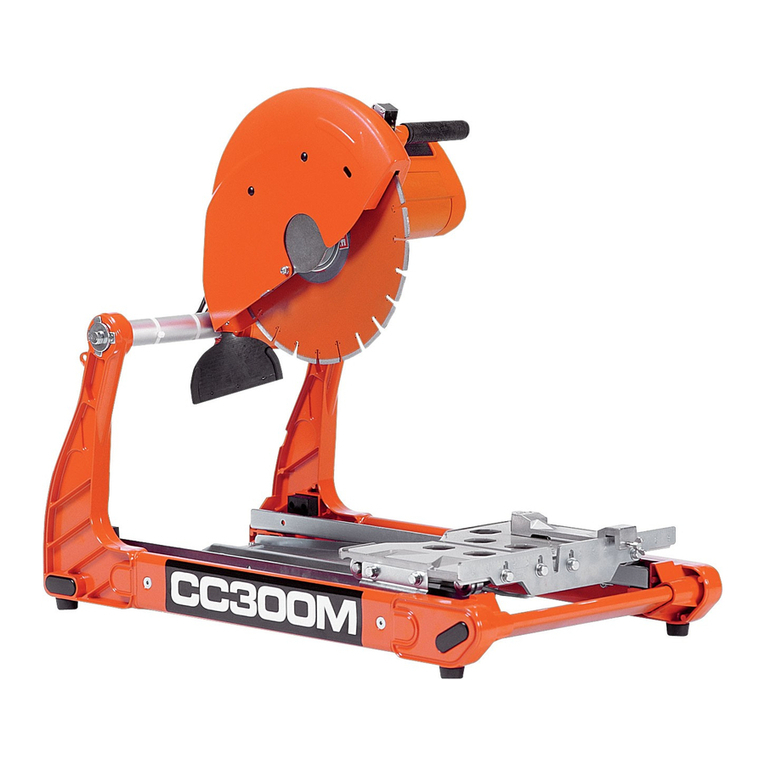
Diamond Products
Diamond Products CC350M Series owner's manual
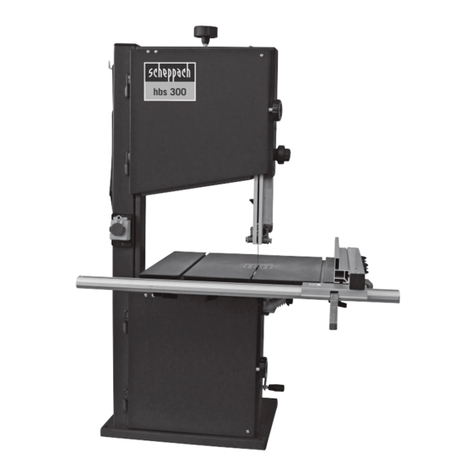
Scheppach
Scheppach HBS300 Translation from the original instruction manual
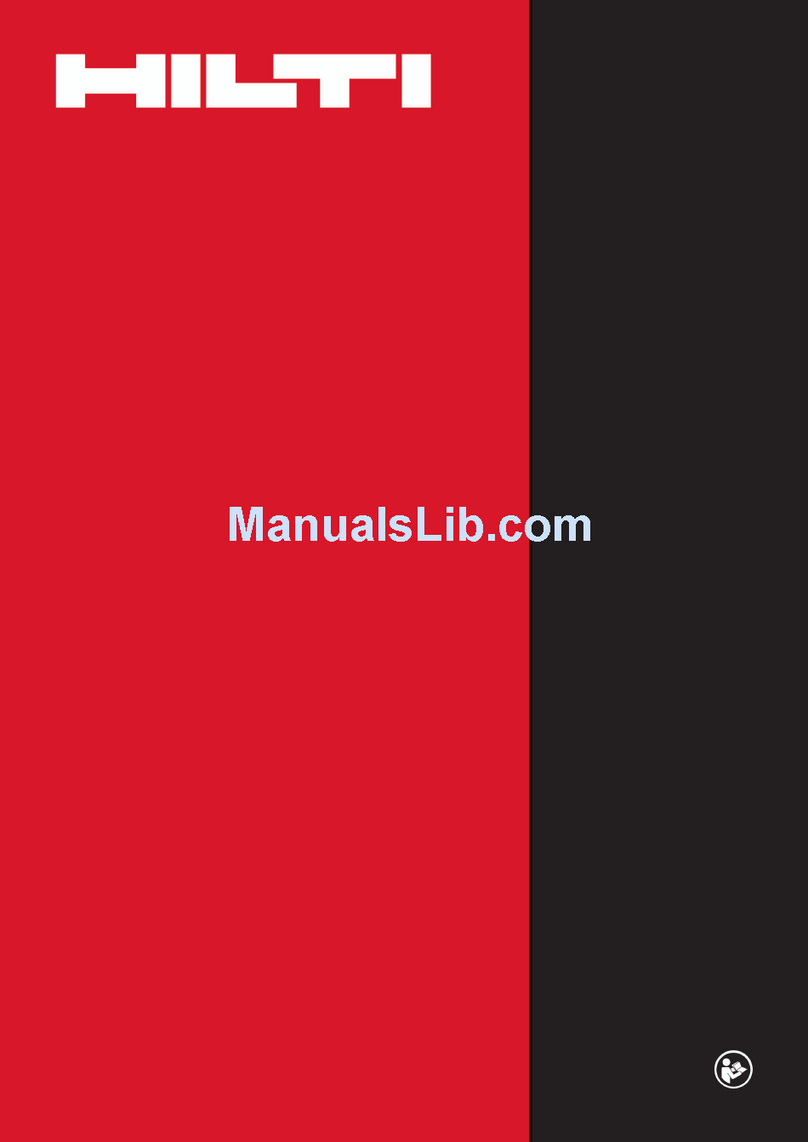
Hilti
Hilti SCW 18-A Original operating instructions
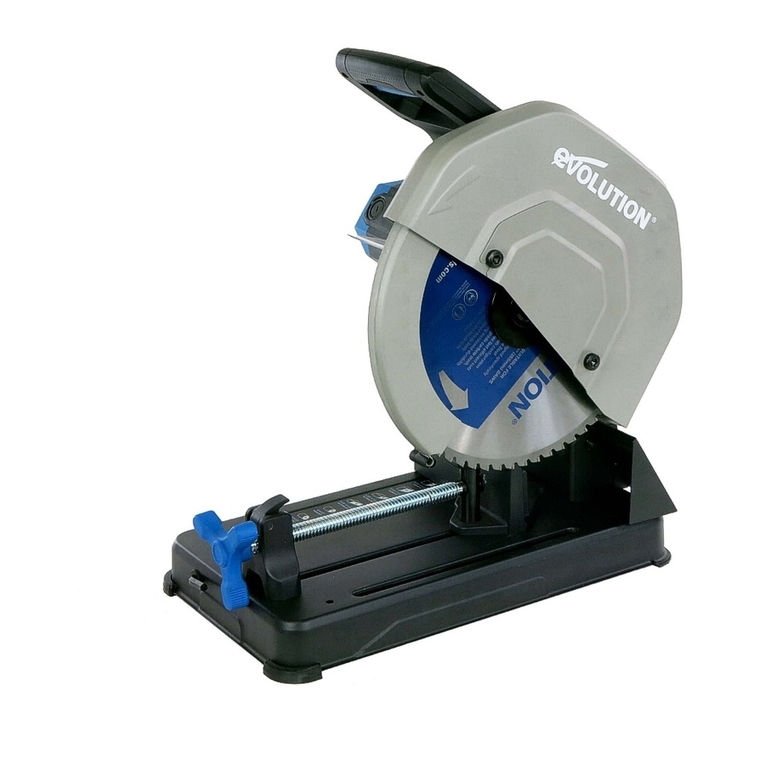
Evolution
Evolution S355CPSL Original instructions
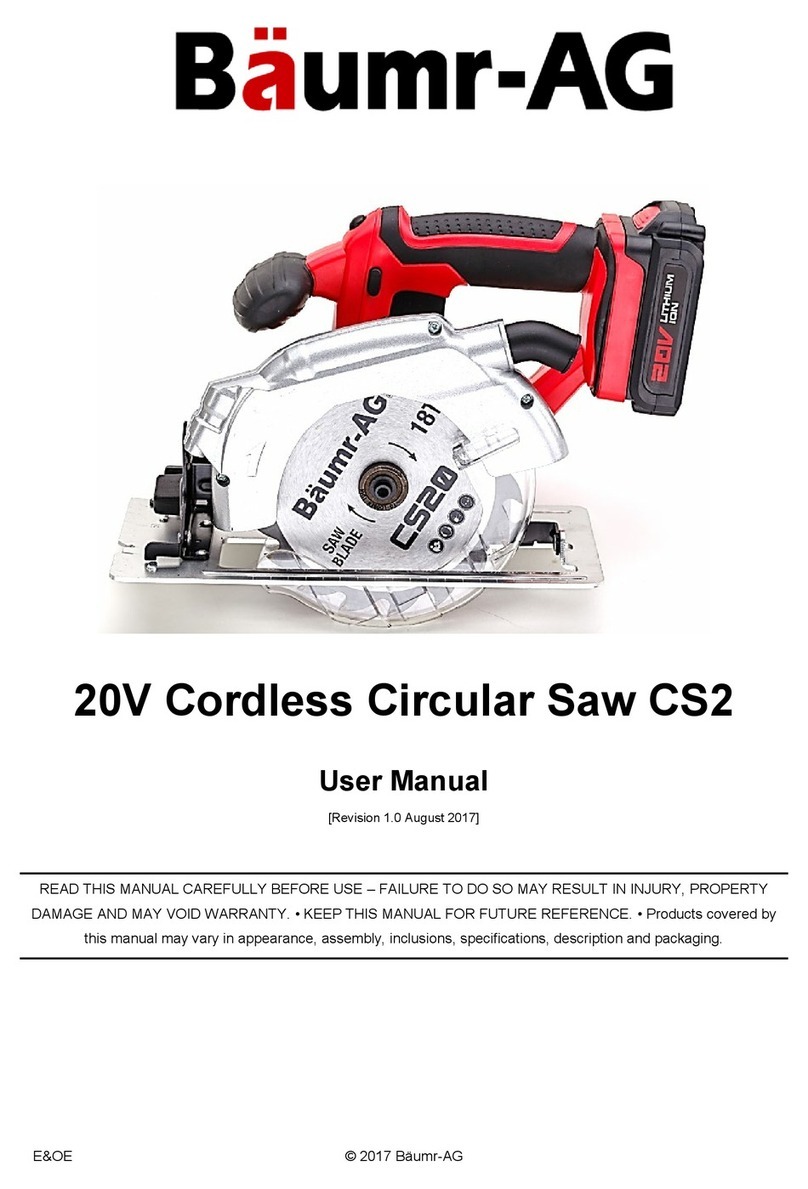
Baumr-AG
Baumr-AG CS2 user manual

DeWalt
DeWalt XR Li-Ion DCS380 instruction manual
